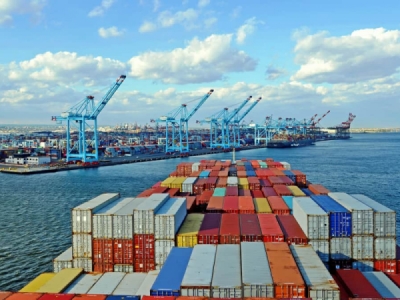
Posted on September 17, 2020
By Costas Paris
The trade rift with China and a boost in e-commerce are changing the way cargo comes into the U.S., with a greater share of goods flowing into East Coast seaports rather than the traditional gateways on the West Coast.
The arrival of the 15,000-container ship CMA CGM Brazil in New York last weekend, the biggest container vessel ever to call on the East Coast, signals a growing change to meet the needs of e-commerce giants like Amazon.com Inc. and Walmart Inc. that are taking more space on ships and looking for faster and cheaper cargo movements.
“The shift started before Covid, with the tariff friction with China,” said Sam Ruda, port director at the Port Authority of New York and New Jersey. “The West Coast, which has been dominated by Asia trade, is losing market share. The East Coast is growing because we have Asia trade, European trade, the Mediterranean trade and the Caribbean trade.”
Large ships that move 10,000 boxes or above began calling in New York in 2017 after work to raise the Bayonne Bridge and deepen the port’s navigation channels was completed. That has allowed the port to cater to the larger vessels that can come from Asia through the expanded Panama Canal, which widened its locks in 2016.
Western ports face fewer constraints on their ability to handle big ships. But moving goods beyond the West Coast, particularly to the big population centers East of the Mississippi River, depends on extensive overland networks of trains and trucks.
The U.S. trade dispute with China pushed companies to set up production centers in other Asian countries like Vietnam, Thailand and Cambodia, as well as the Indian subcontinent. That has placed the production centers within easier reach of the U.S. East Coast through trips across the Indian Ocean and through the Suez Canal. Vessels can then make transshipment calls at Mediterranean ports in Europe before crossing the Atlantic Ocean.
“In 2017, we got 30 ultra-large ships calling in,” Mr. Ruda said. “In 2019, we got 143 and this year to date it’s 146, even with Covid. From a network perspective, doing transshipments in the Med and Europe, you get revenue from multiple legs as a carrier.”
The West Coast remains the main entry point for Asian imports. with Los Angeles, moving 9.4 million containers, measured in 20-foot equivalent units, or TEUs, last year. That compared with 7.5 million containers for New York and New Jersey, which displaced Long Beach, Calif., as the country’s second-busiest port.
After a sharp decline this spring at the onset of the pandemic, inbound volumes have ticked up on what port officials on both coasts say are retailer efforts to replenish depleted inventories and growing demand from the consumer e-commerce market.
Overall, West Coast ports handled nearly 38% of all seaborne imports coming into the U.S. in the first seven months of 2020 and East Coast ports handled slightly more than half, according to California-based research firm Beacon Economics, citing U.S. Census figures. That is down from a 47.6% share for the West Coast in 2006 against 41.9% for the East Coast.
The West Coast’s share of fast-growing East Asia trade has tumbled even faster, sliding from 72.9% to 56.7% over the same period, according to Beacon Economics.
Canadian ports like Vancouver and Prince Rupert, British Columbia, that offer significantly lower prices to move cargo are also siphoning business away from the U.S. West Coast.
“We’ve lost market share for two decades, 20% to be exact, and that cargo has gone to other ports in British Columbia and the Gulf,” said Gene Seroka, executive director at the Port of Los Angeles.
He said labor costs are a significant factor for West Coast ports, where dockworkers are represented by the International Longshore and Warehouse Union. Workers at East and Gulf Coast ports are represented by the International Longshoremen’s Association, but some Southeast ports, including Georgia’s Port of Savannah and South Carolina’s Port of Charleston, have relatively looser labor rules because of state laws.
“Moving a container through the Port of Los Angeles is two times the amount that it costs at a right-to-work port state in the Southeast U.S.,” said Mr. Seroka.
U.S. ports along the Pacific coast, including those in Oakland, Calif., Seattle and Tacoma, Wash., started talks this year on forming a joint effort to make the region’s ports more competitive and attract more cargo.
“We’ve brought together organized labor, employers and for the first time the two Western railroads. It’s the most serious and high level topic we’re focused on,” Mr. Seroka said.
The production shift from China will continue to boost cargo coming into Eastern ports, which are investing heavily to bring in bigger ships. The Port of Savannah, the country’s fourth-busiest gateway, has earmarked $3 billion over the next 12 years for infrastructure to handle multiple ultra-large container vessels simultaneously.
“The West Coast is fighting two battlegrounds,” said Walter Kemmsies, economist and chief strategist at the ports, airports and global infrastructure division at real-estate firm JLL. “It’s the shift of imports from western Asian countries like India and Vietnam and the East Coast port investments to attract imports through the Suez Canal.”
He said the West Coast is “still very much in the game” but the ports must work together and get the railways to move more cargo.
Write to Costas Paris at costas.paris@wsj.com





